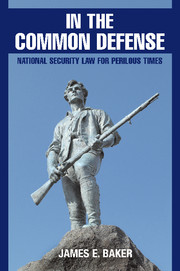Book contents
- Frontmatter
- Contents
- Acknowledgments
- Abbreviations
- Introduction
- 1 Perilous Times: Describing the Threat
- 2 The Meaning of National Security
- 3 National Security Law
- 4 Constitutional Framework
- 5 Electronic Surveillance: Constitutional Law Applied
- 6 National Security Process
- 7 Intelligence
- 8 Use of Military Force
- 9 Homeland Security
- 10 The National Security Lawyer
- Attachments
- Notes
- Index
5 - Electronic Surveillance: Constitutional Law Applied
Published online by Cambridge University Press: 26 July 2009
- Frontmatter
- Contents
- Acknowledgments
- Abbreviations
- Introduction
- 1 Perilous Times: Describing the Threat
- 2 The Meaning of National Security
- 3 National Security Law
- 4 Constitutional Framework
- 5 Electronic Surveillance: Constitutional Law Applied
- 6 National Security Process
- 7 Intelligence
- 8 Use of Military Force
- 9 Homeland Security
- 10 The National Security Lawyer
- Attachments
- Notes
- Index
Summary
LEGAL AND HISTORICAL BACKGROUND
Presidents have engaged in the practice of domestic and foreign intelligence collection since the advent of the United States. The colonies' envoy to France, for example, was America's first great, and perhaps its greatest, intelligence officer: Benjamin Franklin. At home, as Geoffrey Stone has illustrated, presidents authorized all measure of intrusion to identify persons engaged in espionage as well as to deter internal dissent. Electronic surveillance would come later, during the Civil War with the tapping of telegraph lines, and then in earnest following Alexander Graham Bell. But the concept of eavesdropping was clearly not new to the telephonic, electronic, computer, or Internet age. The term “eavesdropping” derives from agents standing under the eave of a house to listen to the conversations taking place within.
As historians have documented, in the landline age, presidents routinely authorized electronic surveillance (wiretapping) to collect foreign intelligence. In 1996, for example, the government declassified and released a history of its eavesdropping efforts on Soviet targets within the United States, known by the program name of Venona. In 1978, the Church Committee also revealed that
Since the 1930's, intelligence agencies have frequently wiretapped and bugged American citizens without the benefit of judicial warrant … past subjects of these surveillances have included a United States Congressman, Congressional staff members, journalists, newsmen, and numerous individuals and groups who engaged in no criminal activity and who posed no genuine threat to the national security, such as two White House domestic affairs advisors and an anti-Vietnam War protest group.
- Type
- Chapter
- Information
- In the Common DefenseNational Security Law for Perilous Times, pp. 71 - 98Publisher: Cambridge University PressPrint publication year: 2007



